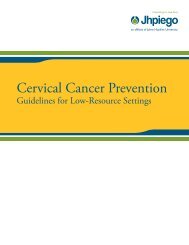Manual for Male Circumcision under Local Anaesthesia
Manual for Male Circumcision under Local Anaesthesia
Manual for Male Circumcision under Local Anaesthesia
Create successful ePaper yourself
Turn your PDF publications into a flip-book with our unique Google optimized e-Paper software.
<strong>Male</strong> circumcision <strong>under</strong> local anaesthesia<br />
Version 3.1 (Dec09)<br />
Urinary tract infections<br />
Urinary tract infections are infrequent in adult men, but more frequent<br />
in children and older men. Usually there is an <strong>under</strong>lying cause, <strong>for</strong><br />
example, kidney or bladder stones. Symptoms include:<br />
• frequent urge to urinate;<br />
• pain and a burning feeling in the area of the bladder or urethra<br />
during urination (dysuria);<br />
• feeling tired, shaky, and weak (malaise);<br />
• feeling pain in the bladder or urethra even when not urinating;<br />
• passing only a small amount of urine, despite an intense urge to<br />
urinate;<br />
• milky or cloudy urine; sometimes urine may be reddish, indicating<br />
that blood is present;<br />
• fever (suggesting that the infection has reached the kidneys);<br />
• pain in the back or side, below the ribs;<br />
• nausea;<br />
• vomiting.<br />
Urinary tract infections in men should be distinguished from urethral<br />
discharge caused by an STI. A patient with a urinary tract infection<br />
should be told to drink plenty of water, starting immediately. He should<br />
also be given an appropriate. Men and boys with recurrent urinary<br />
tract infection, or who do not respond to treatment at the first level of<br />
care, should be referred <strong>for</strong> further investigations.<br />
Infertility<br />
Between 60 and 80 million couples around the world are infertile, and<br />
most of them live in developing countries. Infertility is defined as<br />
failure to conceive after at least 12 months of unprotected vaginal<br />
intercourse. A large proportion of cases of infertility in developing<br />
countries are attributable to STIs, which can damage the fallopian<br />
tubes in women and obstruct the sperm ducts in men, particularly<br />
when left untreated. Reproductive tract infections in men can affect<br />
the prostate (prostatitis), the epididymis (epididymitis), and the testes<br />
(orchitis). In many societies, childlessness is highly stigmatizing, and<br />
the couple’s emotional response to their infertility is often exacerbated<br />
by family, peer and media pressure. Frequently the female partner is<br />
considered responsible <strong>for</strong> the failure to conceive, commonly resulting<br />
in marital tension, divorce, polygamy or ostracism. However, a WHO<br />
investigation of 5800 infertile couples found that reduced male<br />
reproductive capacity was a contributory factor in at least 50% of<br />
infertile couples. 7 In order to provide more efficient, systematic and<br />
cost-effective care <strong>for</strong> infertile couples, and to improve the accuracy of<br />
diagnoses, health care providers managing an infertile couple should<br />
ensure that all essential in<strong>for</strong>mation is collected. The WHO <strong>Manual</strong> <strong>for</strong><br />
the Standardized Investigation and Diagnosis of the Infertile Couple<br />
provides clear guidelines and a logical sequence of steps <strong>for</strong> clinicians<br />
to follow in evaluating both partners in an infertile couple. 8<br />
Linking male circumcision and other male SRH services Chapter 2-11
















